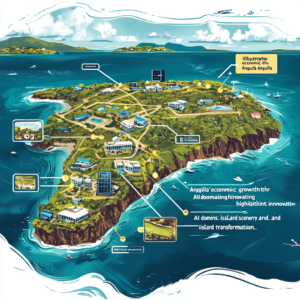
Harnessing Ocean Innovations: Self-Powered Wave Sensors, Breakthrough Biofuels, and Enhanced Catalytic Transformations
Riding the Waves of Change: Tap into the Ocean’s Green Energy Potential
As the world stands at the crossroad of climate crisis and energy transformation, it’s evident that our beloved planet is beckoning us to think outside the box—or, in this case, the shoreline. The ocean, that vast watery expanse teeming with possibilities, is stepping into the spotlight as a treasure trove of renewable energy solutions. Forget the traditional ways of harnessing power—let’s dive deep into some fabulous, mind-bending technologies that’re set to flip the renewable energy game on its head.
Self-Powered Wave Sensors: Nature Meets Innovation
Let’s kick things off with a splashy innovation: self-powered wave sensors! You heard that right. Researchers hailing from Flinders University, hand in hand with some brilliant minds from China, have whipped up what they call a Hybrid Self-Powered Wave Sensor (let’s call it HSP-WS for short because who doesn’t love a good abbreviation?). This nifty little device is not just a spectator of ocean waves; it’s a participant!
So, how does it work? Brace yourself for some techno magic. The HSP-WS brilliantly combines the wonders of an electromagnetic generator with the pizzazz of a triboelectric nanogenerator. Worry not if you’re not a science whiz; simply put, this gadget captures the kinetic energy generated by ocean waves to power itself up. If that’s not a jaw-dropper, it also detects minuscule shifts in wave amplitude—down to 0.5 cm—making it way more sensitive than your average radar sensors. Talk about efficiency! The data harvested can fill significant gaps in wave spectrum analysis, fine-tuning how we harness the tumultuous dance of our oceans for renewable energy.
Biofuel from Sea? Yes, Please!
Now, if you thought fuel means fossil and therefore must come from deep within the Earth, think again! Enter the intriguing realm of biofuel derived from marine microalgae, which scientists over at Flinders University are diving into headfirst. With innovations surrounding the growth and lipid accumulation of these wondrous little plants, we are talking about biofuels that are not only eco-friendly but also outrageously efficient.
What’s the secret sauce? Researchers have ushered in an aggregation-induced emission (AIE) photosensitizer to the party, significantly boosting the photosynthetic powers of Chlamydomonas reinhardtii—a fancy name for a type of green microalga. This advancement leads to impressive growth and lipid accumulation, which are the building blocks for next-gen biofuels. It’s a testament that marine microalgae, apart from their quirky green charm, could outperform terrestrial plants by up to 50 times in efficiency.
Catalyzing Change: The Role of Advanced Nanotechnology
The energy world is set to catch another wave with the focus on improving catalytic conversion processes, and Flinders University has got its foot on the accelerator. Through pioneering nanotechnology, researchers are working their magic to enhance catalytic conversion in engines, upping the ante for green fuels.
The spotlight here shines on electrocatalytic gas conversion—think of it as turning energy use from a clunky old machine into a sleek sports car! This requires catalysts that can perform like seasoned pros. A new plasma coating technique for these micro- and nanotextured electrocatalyst materials promises to jazz things up. With improved hydrophobicity and sparkly catalytic performance, we’re carving out a more efficient roadmap toward utilizing green fuels—and trust, the planet could use every bit of help it can get.
The Ocean’s Energy Buffet: More Than Just Waves
We’ve only scratched the surface, my friend. Let’s venture further into the sea, where a cornucopia of ocean-based renewable energies are sitting pretty, just waiting to be tapped.
Take wave power, for instance. This marvel siphons off energy created from our restless ocean waves to generate electricity, desalinate water, or pump it into friendly reservoirs. Wave Energy Converters (WECs) can cozy up on the shore, chill not too far from the edge, or even float on the deep blue.
Then there’s tidal power, which rides the natural currents created by the dance of tides. Sure, it’s not taking off like a rocket yet—thanks to its higher costs and limited locations, but its reliability as an energy source has future energy enthusiasts buzzing.
What about marine current power? Oh boy, let me tell you—this one captures the relentless streams of ocean currents, such as the legendary Gulf Stream. With more reliable outputs compared to breezy wind and sun, marine currents could become the rock stars of the renewable energy world.
Ocean Thermal Energy Conversion (OTEC) is another player in this saga of potential. By harnessing the temperature difference between chilly deep-sea waters and warm surface waters, OTEC can generate energy continuously. Weather? Who cares! This bad boy doesn’t depend on the sun or wind and could yield energy outputs that challenge wave or tidal power by a whopping 100 times!
And, let’s not overlook osmotic power—converting the salt level differences between sea and river water into useable energy. It’s eco-friendly, but you might want to keep an eye on the potential impacts of salty discharges back into the ocean.
Casting a Vision for Tomorrow’s Oceanic Energy Revolution
Now, let’s hit pause and step back for a moment. Ocean-based renewable energy is not just a fanciful dream; it is steadily emerging into our reality, and the investments and technological advancements are impressive to behold.
Recent reports have shown that global pledges regarding offshore wind power have seen a dramatic doubling in just four years—a clear indication that the tides are turning! By 2050, the ambition is to deploy a whopping 2,000 GW of offshore wind power, enough to provide electricity to around 1.5 billion households every year.
But let’s keep it real. While the prospects are undeniably exciting, they come hand in hand with challenges. The potential for disrupting natural habitats, conflicts over ocean space usage, and the visual implications of offshore turbines must find balance against all the benefits we hope to gain.
A Final Thought: Take the Plunge!
So, where do we go from here? The ocean is not just a pretty blue backdrop; it holds the keys to a sustainable energy future if we choose to unlock them. With innovations like self-powered wave sensors, exciting biofuels, and state-of-the-art catalytic conversions, the future feels incredibly bright.
As stewards of our planet, we need to embrace these advancements and advocate for their further exploration. Who knows—the next environmental champion could be hiding just beneath the surf!
Want to stay up to date with the latest news on neural networks and automation? Subscribe to our Telegram channel: @channel_neirotoken. Dive into the current of knowledge and innovation!

